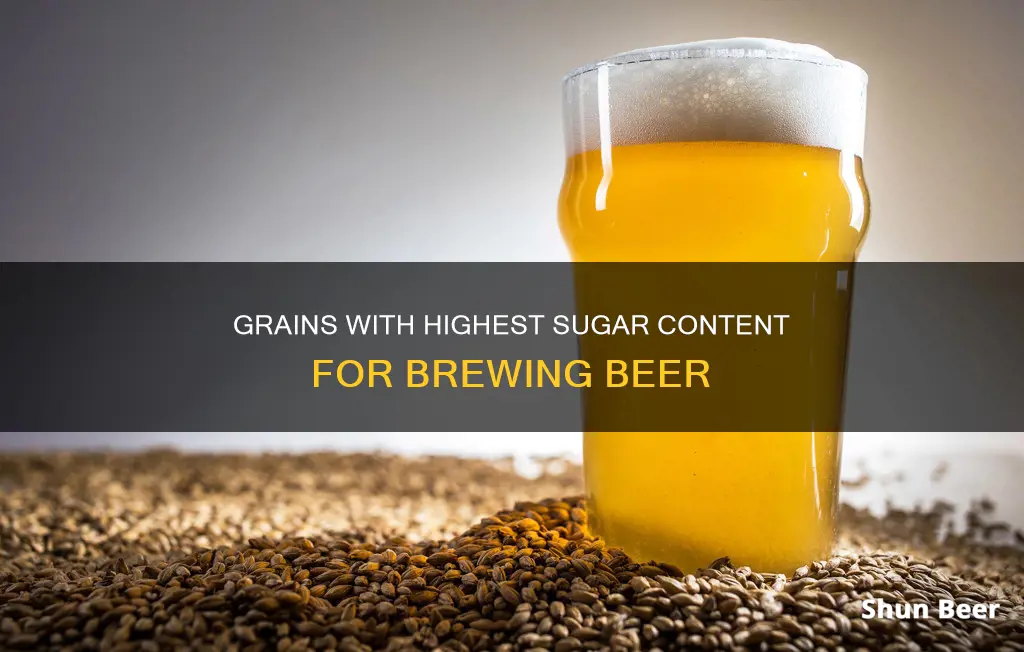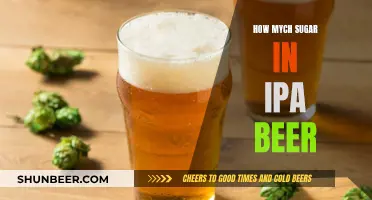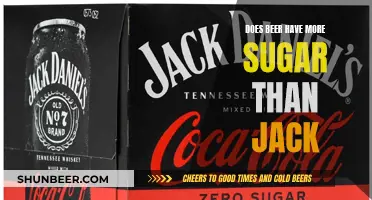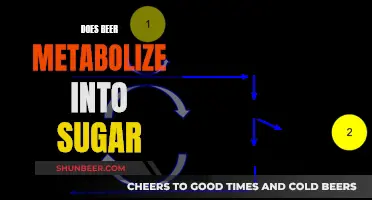
Beer is made from grains, spices, yeast, and water. Although sugar is not added to the list, it is essential for the fermentation and production of beer. The sugar in beer comes from the grains, specifically barley and wheat, which are the most commonly used grains. During the malting process, grains are soaked, germinated, and dried to convert stored starches into fermentable sugars. The amount of sugar in beer depends on the type of grain and the quantity used. The more grain present, the more sugar can be extracted.
What You'll Learn

Beer's sugar content is derived from the fermentation process
At this stage, the wort is ready for fermentation. Yeast is introduced to the wort, initiating the conversion of sugars into alcohol and carbon dioxide. This fermentation process is crucial, as it decreases the sugar content while increasing the alcohol content of the beer. The final product is then stored and left to mature, resulting in the beer we know and love.
The sugar content of beer is influenced by several factors, including its gravity, the type of yeast used, and any additional flavourings such as honey or corn syrup. The specific combination of grains and the fermentation process determines the unique sugar profile of each beer.
While beer typically contains a low amount of sugar, the sugar present plays a vital role in the fermentation process, providing the yeast with the necessary nutrients to produce alcohol. This transformation of sugars into alcohol is what gives beer its distinctive characteristics, contributing to the overall flavour, aroma, and alcohol content.
The fermentation process also influences the final sugar content of the beer. During fermentation, the yeast feeds on the sugars, causing the sugar content to decrease. As a result, the final sugar level in beer depends on the initial sugar concentration in the wort and the efficiency of the yeast in converting those sugars.
Goldberg Beer: Sugar Content and Nutritional Facts
You may want to see also

Beer gravity influences sweetness and alcohol content
Beer gravity, or specific gravity, is a measure of the density of the wort (the sugar-containing liquid extracted from the mashing process) compared to water. It is influenced by the sugar content of the wort, with a high sugar concentration resulting in a high gravity wort.
During fermentation, yeast is added to the wort, which converts sugars into alcohol and carbon dioxide. As the yeast ferments the wort, its sugar content decreases while its alcohol content increases, lowering its gravity and resulting in a beer with a higher alcohol content. This process is known as beer gravity, and it influences the sweetness and alcohol content of the final beer.
The original gravity (OG) of a beer indicates the number of dissolved sugars in the beer that can be converted into alcohol. A higher OG indicates a higher potential alcohol percentage in the final beer. Conversely, session beers and dry, less sweet beers have lower dissolved sugar content and, consequently, lower gravity and alcohol content.
The final gravity (FG) of a beer is also an important indicator of its sweetness and alcohol content. A higher FG generally indicates a sweeter-tasting beer, as more sugar remains unfermented. However, other factors such as hop bitterness, alcohol content, and mash temperatures can also influence the perceived sweetness of a beer.
Overall, beer gravity plays a crucial role in determining the sweetness and alcohol content of the final beer. Brewers can manipulate various factors, such as yeast selection, fermentation temperature, and mash thickness, to control the gravity and, consequently, the sweetness and alcohol content of their beers.
Beer vs Soda: Which Has More Sugar?
You may want to see also

Beer's main type of sugar is maltose
Beer is generally made from grains, spices, yeast, and water. Although sugar is not added to the list of ingredients, it is created naturally when grains are processed and fermented by yeast. This is an essential step in the production of beer.
The brewing process begins with malting, which involves the controlled germination of grains, usually barley and wheat. This germination process breaks down the stored starch in the grains into fermentable sugars, mainly maltose. The malted grains are then mashed, roasted, milled, and soaked in hot water to create a sugar-containing liquid called wort.
Maltose is a disaccharide, a type of simple sugar made up of two glucose molecules. It is the principal sugar in wort and is derived from the breakdown of starch during the mashing process. During fermentation, the maltose in the wort is transported into the yeast cell, where it is broken down into its constituent glucose molecules and then metabolised into cell components, alcohol, and carbon dioxide.
While maltose is the main type of sugar in beer, it typically only comprises about 80% of the wort's fermentable sugar content. The remaining 20% consists of oligosaccharides, which yeast does not ferment, and the body cannot digest. Therefore, despite beer containing a significant amount of carbohydrates, its sugar content tends to be relatively low.
The final sugar content of a beer depends on several factors, including its gravity, the type of yeast used, and any additional flavourings added, such as honey or corn syrup. However, it is challenging to determine the exact sugar content of a beer, as labelling regulations for alcoholic beverages in the United States do not require manufacturers to disclose this information.
Natural Sugar in Beer: What's the Truth?
You may want to see also

Yeast ferments sugar into alcohol and carbon dioxide
The process of converting sugar into alcohol and carbon dioxide is called alcoholic fermentation or ethanol fermentation. It is a biological process performed by yeast cells, which convert sugar into carbon dioxide and ethyl alcohol. Yeast is a member of the fungi family and is considered a eukaryotic micro-organism.
The process of alcoholic fermentation is complex, and the reactions within the yeast cell are intricate. However, the overall process can be summarised as follows:
> Sugar + Energy (stored in ATP) => Alcohol + Carbon Dioxide + Energy (Glucose) (Ethyl Alcohol)
During fermentation, yeast consumes sugar and produces ethanol and carbon dioxide as waste products. The carbon dioxide escapes or dissolves into the liquid, creating bubbles and causing it to become fizzy. The pressure build-up from carbon dioxide production in a confined space can be immense and can even cause the explosion of a sealed glass bottle. Alcohol is the other by-product of fermentation, which remains in the liquid.
- Mashing: The grains are roasted, milled, and soaked in hot water, resulting in a sugar-containing liquid called wort.
- Boiling: Hops or other spices are added to the wort, which is then cooled and filtrated to remove plant residue.
- Fermentation: Yeast is added to the wort to convert sugars into alcohol and carbon dioxide.
- Maturation: The final step where the beer is stored and left to age.
The efficiency of yeast and fermentation conditions can alter the proportions of various by-products, and different yeast strains have different alcohol tolerances. Brewer's yeast, for example, can tolerate up to about 5% alcohol, while wine yeast can tolerate up to 12%.
Beer vs. Chardonnay: Which Has More Sugar?
You may want to see also

Beer styles exhibit distinct sugar profiles
Ale vs. Lager
The distinction between these two beer families is not just about flavour profiles but also the type of yeast used and how they ferment, which significantly impacts their sugar and alcohol content.
Ales are fermented with Saccharomyces cerevisiae, a top-fermenting yeast that works best at warmer temperatures. This yeast tends to ferment quickly and can digest a variety of sugars, which can lead to a higher alcohol content. However, because of its vigorous fermentation, it sometimes leaves behind less sugar, resulting in a drier finish.
In contrast, lagers use Saccharomyces pastorianus, a bottom-fermenting yeast that prefers cooler temperatures and ferments more slowly and cleanly. This method typically results in a crisper and clearer beer with a lighter taste and, often, a slightly higher sugar content due to more residual unfermented sugars.
India Pale Ale (IPA)
IPAs can vary in sugar content, but they often have a higher level of residual sugars, which contributes to a fuller body and balanced bitterness. Compared to regular and light beers, IPAs typically have less than 1 gram of residual sugar per 12-ounce serving.
Stout
Stouts are known for their dark, rich, and roasty character, and they can range widely in sugar content. Dry stouts tend to have lower sugar, while milk stouts (which include lactose, a non-fermentable sugar) or imperial stouts (with high gravity) are on the sweeter side.
Low Gravity vs. High Gravity Beers
Low gravity beers begin with less sugary wort, leading to a beer that is lower in both alcohol content and residual sweetness. High gravity beers, on the other hand, start with a wort that is rich in sugars, resulting in a beer that is higher in alcohol and often sweeter in taste.
Michelob Ultra Beer: Sugar-Free or Sweet Deception?
You may want to see also
Frequently asked questions
Beer is made from a combination of water, grains (often barley or wheat), hops, and yeast.
Sugar in beer is created by the fermentation of grains. During the malting process, grains are soaked, germinated, and dried to convert stored starches into fermentable sugars.
The most common type of sugar in beer is maltose, which is released from the grain when mixed with hot water.
Barley and wheat are the grains that contain the most sugar for beer, as they are the most commonly used in the brewing process.







